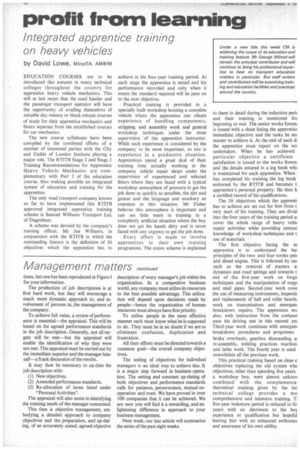profit from learning
Page 88

If you've noticed an error in this article please click here to report it so we can fix it.
Integrated apprentice training on heavy vehicles
by David Lowe, MInstTA, AMBIM
EDUCATION COURSES are to be introduced this autumn in many technical colleges throughout the country for apprentice heavy vehicle mechanics. This will at last mean that the road haulier and the passenger transport operator will have the opportunity of availing themselves of suitable day-release or block-release courses of study for their apprentice mechanics and fitters separate from the established courses for car mechanics.
The new course syllabuses have been compiled by the combined efforts of a number of interested parties with the City and Guilds of London Institute playing a major role. The RTITB Stage 2 and Stage 3 Training Recommendations for Apprentice Heavy Vehicle Mechanics are complementary with Part 2 of the education course, thus making possible an integrated system of education and training for the apprentice.
The only road transport company known so far to have implemented this RTITB approved integrated apprentice training scheme is Samuel Williams Transport Ltd, of Dagenham.
A scheme was devised by the company's training officer, Mr Joe Williams, in conjunction with the RTITB in which the outstanding feature is the definition of 56 objectives which the apprentice has to achieve in his four-year training period. At each stage the apprentice is tested and his performance recorded and only when it meets the standard required will he pass on to the next objective.
Practical training is provided in a specially built workshop housing a complete vehicle where the apprentice can obtain experience of handling components, stripping and assembly work and general workshop techniques under the close supervision of the apprentice instructor. While such experience is considered by the company to be most important, so too is experience in a productive situation. Apprentices spend a great deal of their training time actually working in the company vehicle repair shops under the supervision of experienced and selected fitters where they are faced with a typical workshop atmosphere of pressure to get the job done as quickly as possible, the dirt and grease and the language and mockery so common to this situation. Mr Fisher believes this atmosphere is important and can see little merit in training in a completely artificial situation where the boy does not get his hands dirty and is never faced with any urgency to get the job done.
Every effort is made to involve apprentices in their own training programme. The entire scheme is explained to them in detail during the induction perit and their training is monitored fro beginning to end. The senior works foram is issued with a sheet listing the apprentict immediate objective and the tasks he mt master to achieve it. At the end of each tt the apprentice must report on the wo undertaken. When he has achieved particular objective a certificate satisfaction is issued to the works forent and the details entered in a log book whil is maintained for each apprentice. When has completed his training the log book endorsed by the RTITB and becomes t apprentice's personal property. He then h a certified record of his qualifications.
The 56 objectives which the apprenti has to achieve are set out for him from t very start of his training. They are divid into the four years of the training period x cover the whole range of heavy vehic repair activities while providing extensi knowledge of workshop techniques and t use of materials.
The first objective facing the nt apprentice, is to understand the Nu principles of the twoand four-stroke pett and diesel engine. This is followed by tas such as the removal of starters al dynamos and road springs and towards t end of the first-year work on forgit techniques and the manipulation of copp and steel pipes. Second-year work cove the use of measuring instruments, inspectit and replacement of ball and roller bearin work on transmissions and emergen1 breakdown repairs. The apprentice mu also, with instruction from the compan pass his driving test in this second ye Third-year work continues with emergen1 breakdown procedures and progresses brake overhauls, gearbox dismantling al re-assembly, welding practices machini and lathe work. The fourth year is used consolidate all the previous work.
This practical training based on clear-c objectives replacing the old system whe objectives, other than spending five years a workshop boy, were almost unknov combined with the complementa theoretical training given by the loc technical college provides a mo comprehensive and intensive training. TI five-year indenture period is reduced to fo years with no detriment to the bo3 experience or qualification but hopeful leaving him with an enhanced enthusias and assurance of his own ability.










































































































































